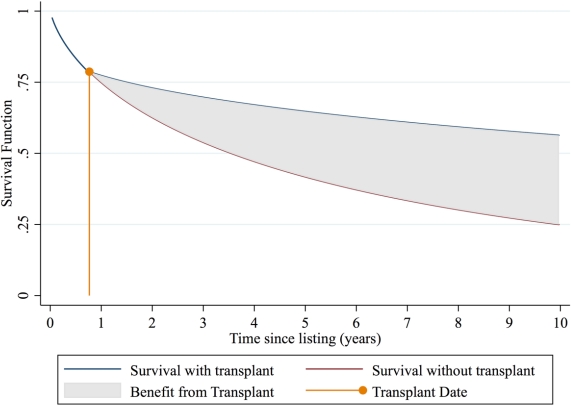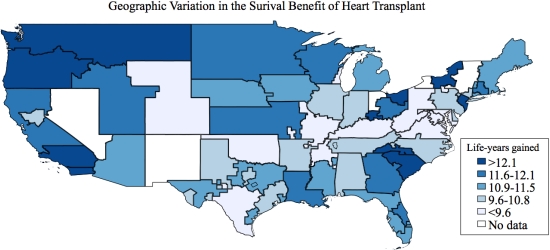Geographic Variation in the Survival Benefit of Heart Transplantation
1University of Chicago, Chicago, IL
2Northwestern University, Chicago, IL.
Meeting: 2018 American Transplant Congress
Abstract number: 255
Keywords: Allocation, Heart, Public policy, Survival
Session Information
Session Name: Concurrent Session: Location, Location, Allocation in Heart Transplantation
Session Type: Concurrent Session
Date: Monday, June 4, 2018
Session Time: 2:30pm-4:00pm
 Presentation Time: 2:54pm-3:06pm
Presentation Time: 2:54pm-3:06pm
Location: Room 4C-3
Purpose: Heart transplant candidate selection and treatment practices vary substantially across the US. We aimed to determine if transplant center practices modify the survival benefit conferred by heart transplantation.
Methods: SRTR data on all adult heart transplant candidates listed from 2006-2015 were collected. A mixed-effects discrete-time survival model was used to estimate variation in heart transplant survival benefit between centers. For each recipient, survival with transplant was compared to predicted survival without transplant to estimate the “life-years gained” projected over 40 years post-transplant, accounting for pre-transplant waiting time (example displayed in Fig 1). The model adjusted for candidate mix by including covariates associated with wait-list and post-transplant survival (age, diagnosis, renal function, ICD, and life support).
Results: From 2006-2015, 110 centers listed 30,018 adult candidates and 20,166 were transplanted. The average waiting-time and candidate-adjusted benefit of heart transplant was 11.2 years, with center rates ranging from 5.4-16.6 years. Top quintile centers saved an additional 4.9 life-years per heart compared to bottom quintile (13.7 years vs. 7.5 years, p<0.01). Fig 2 displays the geographic variation in survival benefit aggregated at the OPO level. Patients supported with continuous flow left ventricular assist devices had a significantly smaller benefit from transplant than average (8.6 years). Status 1A candidates supported with high dose inotropes or intra-aortic balloon pumps had larger than average survival benefits (17 years and 15.6 years).
Conclusions: In the current US heart allocation system, there is wide inter-center variation in the benefit from heart transplant. Center practices have a significant impact on the number of life years gained from heart transplant.
CITATION INFORMATION: Parker W., Gibbons R., Churpek M., Anderson A. Geographic Variation in the Survival Benefit of Heart Transplantation Am J Transplant. 2017;17 (suppl 3).
To cite this abstract in AMA style:
Parker W, Gibbons R, Churpek M, Anderson A. Geographic Variation in the Survival Benefit of Heart Transplantation [abstract]. https://atcmeetingabstracts.com/abstract/geographic-variation-in-the-survival-benefit-of-heart-transplantation/. Accessed December 17, 2025.« Back to 2018 American Transplant Congress


